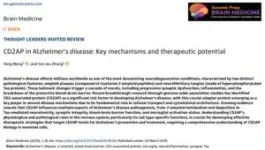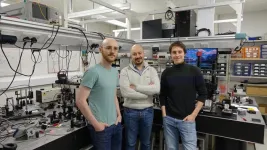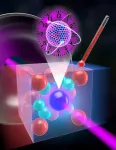(Press-News.org) XIAMEN, China, 18 March 2025 – A groundbreaking peer-reviewed Thought Leaders Invited Review article in Brain Medicine (Genomic Press, New York) explores how CD2-associated protein (CD2AP) contributes to Alzheimer’s disease (AD), one of the most devastating neurodegenerative disorders affecting millions worldwide. CD2AP, initially identified for its role in cellular transport and cytoskeletal architecture, has now emerged as a crucial factor in AD pathology.
Genome-wide association studies (GWAS) have established CD2AP as a major genetic risk factor for late-onset Alzheimer’s disease (LOAD), with increasing evidence linking it to amyloid metabolism, tau pathology, synaptic integrity, and neuroinflammation.
“CD2AP is a fascinating molecule because it functions at the intersection of multiple pathways implicated in Alzheimer’s disease,” said Professor Yun-wu Zhang, corresponding author of the review. “By understanding its precise role in different brain cells, we may unlock new treatment strategies for this complex disorder.”
The Role of CD2AP in Amyloid-Beta Metabolism
Aβ accumulation and plaque formation are central to AD pathogenesis. CD2AP has been found to regulate Aβ metabolism by controlling the trafficking and degradation of amyloid precursor protein (APP). Studies show that CD2AP deficiency results in increased Aβ production and reduced clearance, accelerating plaque formation.
“CD2AP may play a dual role in amyloid regulation,” explained Professor Zhang. “On one hand, it limits excessive Aβ production, and on the other, it helps remove toxic amyloid aggregates. Disruptions in either function can tip the balance toward neurodegeneration.”
CD2AP and Synaptic Integrity: A Double-Edged Sword
Synapse loss is a strong predictor of cognitive decline in AD, and CD2AP is crucial for maintaining synaptic structure and function. However, the protein’s impact varies depending on the cell type. In neurons, CD2AP is essential for dendritic spine formation and stability, while in microglia, excessive CD2AP activity may promote pathological synapse pruning.
Recent studies indicate that loss of CD2AP in neurons leads to reduced spine density and impaired synaptic plasticity, key mechanisms underlying memory loss in AD.
“Neurons and microglia seem to have opposing needs when it comes to CD2AP,” said Mr. Yong Wang, co-author of the review. “In neurons, CD2AP is protective, but in microglia, too much CD2AP might actually worsen synapse loss. This makes it a challenging but exciting therapeutic target.”
Neuroinflammation and CD2AP: The Microglial Connection
Microglial activation is a hallmark of AD, and CD2AP plays a key role in modulating microglial responses to amyloid plaques. The review highlights that CD2AP-deficient microglia exhibit reduced phagocytosis, leading to increased amyloid burden. However, excessive CD2AP activity in microglia is linked to heightened synaptic pruning and inflammation, potentially worsening neurodegeneration.
“Microglial CD2AP levels need to be carefully balanced,” said Mr. Wang. “Too little CD2AP results in inefficient amyloid clearance, while too much may contribute to neuroinflammation and synaptic loss.”
CD2AP and Tau Pathology
Beyond its role in amyloid regulation, CD2AP has been implicated in tau-mediated neurotoxicity. Tau tangles, another defining feature of AD, disrupt neuronal function and contribute to cognitive impairment. Studies show that certain CD2AP variants are associated with increased tau phosphorylation, which exacerbates neuronal damage.
“This is an area that requires further investigation,” Mr. Wang added. “Understanding how CD2AP influences tau pathology could provide a missing link between amyloid and tau dysfunction in Alzheimer’s disease.”
Implications for Future Alzheimer’s Treatments
Given its wide-ranging effects, CD2AP presents a unique opportunity for therapeutic intervention. However, its cell type-specific roles complicate drug development. Researchers are now exploring whether targeting CD2AP in a way that enhances neuronal protection while limiting microglial overactivation could be a viable treatment strategy.
“We are just beginning to understand how CD2AP functions across different cell types,” said Professor Zhang. “Our goal is to develop precision therapies that can modulate CD2AP activity in a way that benefits patients without causing unintended consequences.”
Key Questions Moving Forward
Could CD2AP modulation serve as a novel therapeutic strategy for AD?
How can researchers selectively target CD2AP in neurons versus microglia?
What role does CD2AP play in early-stage AD, and could it serve as a biomarker for disease progression?
The peer-reviewed Thought Leaders Invited Review article, “CD2AP in Alzheimer’s disease: Key mechanisms and therapeutic potential,” appears online on 18 March 2025 in Brain Medicine (Genomic Press) and is freely accessible at https://doi.org/10.61373/bm025i.0026.
About Brain Medicine: Brain Medicine (ISSN: 2997-2639) is a peer-reviewed medical research journal published by Genomic Press, New York. Brain Medicine is a new home for the cross-disciplinary pathway from innovation in fundamental neuroscience to translational initiatives in brain medicine. The journal’s scope includes the underlying science, causes, outcomes, treatments, and societal impact of brain disorders across all clinical disciplines and their interface.
END
BRATISLAVA, Slovakia, 18 March 2025 – A pioneering peer-reviewed research study published in Brain Medicine provides compelling evidence that maternal infections during pregnancy can have lasting effects on offspring brain function. Researchers from the Slovak Academy of Sciences investigated the impact of maternal immune activation (MIA) on hippocampal pyramidal neurons in newborn rat offspring and found that prenatal inflammation significantly impairs neuronal excitability. These changes in brain function may underlie the increased risk of neurodevelopmental disorders associated with maternal infections.
“Maternal ...
Zürich/Lausanne, Switzerland – 18 March 2025 – inait today announced a collaboration with Microsoft to accelerate the development and commercialization of inait’s innovative AI technology, using its unique digital brain AI platform. The collaboration will focus on joint product development, go-to-market strategies, and co-selling initiatives, initially targeting the finance and robotics sectors.
inait's AI technology, born from decades of neuroscience research offers a paradigm shift in artificial intelligence. Its “brain programming language” and ability to learn from experience and understand cause and effect delivers cognitive ...
LAUSANNE, March 18, 2025 – The Open Brain Institute (OBI) launches today as a groundbreaking non-profit organization, transforming neuroscience from the physical to the virtual world. Building on the pioneering achievements of the EPFL’s Blue Brain Project, OBI opens the era of simulation neuroscience—empowering researchers to build and simulate digital brains with unprecedented detail, scale, and speed.
AI has been given access to the software recipe to build digital brains, providing natural language support to researchers to explore, build and ...
Helicobacter pylori bacteria is considered to be the main cause of gastric cancer, with the infection rate particularly high in the Asia-Pacific region. Approximately 90% of cases are linked to H. pylori bacterial infections, but preemptive eradication can reduce the incidence of gastric cancer by 30-40%.
However, the increase in antimicrobial drug-resistant bacteria used in eradication therapy is a major issue. In addition, while secondary prevention through endoscopic examinations is also important for the early detection of gastric cancer, it is not clear to what extent Asia-Pacific practitioners recognize its importance.
An international ...
UNDER EMBARGO UNTIL 00:01 AM UK TIME ON TUESDAY 18 MARCH 2025
Almost one in ten people (9.1%) in England think they could have Long Covid but aren’t sure, according to a new analysis of NHS England survey data by the University of Southampton.
Researchers also found that 4.8% of people reported having Long Covid, with higher rates among people living in deprived areas, people with particular ethnic backgrounds, parents or carers, and those with another long-term condition.
The findings are published today [18 March] ...
Researchers at Heriot-Watt University have made a ground-breaking discovery paving the way for a transformative era in photonic technology.
For decades, scientists have theorised the possibility of manipulating the optical properties of light by adding a new dimension—time. This once-elusive concept has now become a reality thanks to nanophotonics experts from the School of Engineering and Physical Sciences in Edinburgh, Scotland.
The team’s breakthrough emerged from experiments with nanomaterials known as transparent conducting oxides (TCOs) - a special ...
(MEMPHIS, Tenn. – March 17, 2025) As the H5N1 avian influenza outbreak continues, scientists are working to better understand the virus’s threat to human health. The virus has been found in dairy cows’ milk and has infected farm workers, prompting scientists at St. Jude Children’s Research Hospital to study potential treatments. Results showed that in a preclinical model, two FDA–approved flu antivirals generally did not successfully treat severe H5N1 infections. Additionally, the researchers found that the route of infection, whether through ...
Thomas Jefferson University has initiated a phase 1 clinical trial for a Lassa virus (LASV) vaccine developed at Jefferson in collaboration with the University of Maryland, Baltimore (UMB), at the Center of Vaccine Development and Global Health, UMB. Currently, there are no approved vaccines against the Lassa virus. The clinical study is a dose-ranging study that will assess the safety and immunogenicity of the candidate vaccine for both the rabies virus and LASV.
The experimental vaccine is based on an attenuated and killed rabies virus vaccine similar to current rabies vaccines and has an additional ...
Outpatient primary care clinics at Hebrew SeniorLife’s Orchard Cove and NewBridge on the Charles communities have been recognized by the Institute for Healthcare Improvement (IHI) as Age-Friendly Health Systems — Committed to Care Excellence.
“I want to express my gratitude to the team at Hebrew SeniorLife for your dedication to age-friendly care,” said Leslie Pelton, MPA, Vice President, Institute for Healthcare Improvement (IHI). “Age-Friendly Health Systems and IHI celebrate your recognition as an Age-Friendly ...
For decades, atomic clocks have been the pinnacle of precision timekeeping, enabling GPS navigation, cutting-edge physics research, and tests of fundamental theories. But researchers at JILA, led by JILA and NIST Fellow and University of Colorado Boulder physics professor Jun Ye, in collaboration with the Technical University of Vienna, are pushing beyond atomic transitions to something potentially even more stable: a nuclear clock. This clock could revolutionize timekeeping by using a uniquely low-energy transition within the nucleus of a thorium-229 atom. This transition is less sensitive to environmental disturbances than modern atomic clocks and has been proposed for tests of fundamental ...








